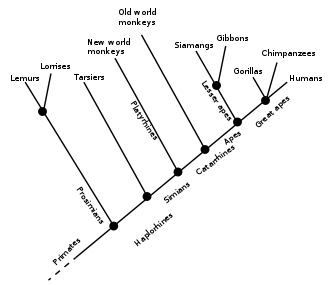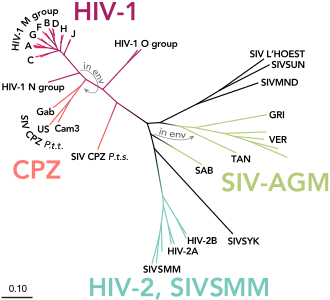Clade





Clade is a term used in biology and evolutionary biology to describe a group of organisms that consists of a single common ancestor and all its lineal descendants, representing a single branch on the tree of life. The concept is central to the field of phylogenetics, which studies the evolutionary relationships among organisms. Clades are also referred to as monophyletic groups. Understanding clades is crucial for the classification and study of life forms, tracing their evolutionary history, and understanding the relationships between different species.
Definition and Characteristics[edit]
A clade is defined by the concept of monophyly, which refers to a group of organisms that includes an ancestor and all of its descendants. This is in contrast to paraphyletic and polyphyletic groups, which respectively do not include all descendants of a common ancestor or combine organisms from different ancestors. Clades are identified through the study of morphological and genetic characteristics that are inherited from the common ancestor.
Importance in Biological Classification[edit]
The use of clades has revolutionized the way scientists classify organisms. The traditional Linnaean taxonomy, which groups organisms based on shared characteristics, has been supplemented by cladistics, a method that classifies organisms based on their evolutionary history and relationships. This shift towards a phylogenetic classification system has led to a more accurate representation of the evolutionary relationships among organisms.
Methods for Determining Clades[edit]
Determining the composition of a clade typically involves the analysis of DNA sequences or morphological data to construct a phylogenetic tree, a diagram that represents evolutionary relationships. Techniques such as comparative genomics, molecular phylogenetics, and bioinformatics play a crucial role in identifying and understanding clades.
Examples of Clades[edit]
Examples of well-known clades include the Mammalia, which encompasses all mammals, the Aves for birds, and the Angiospermae for flowering plants. These clades are defined by specific evolutionary traits inherited from their common ancestor, such as the presence of mammary glands in mammals, feathers in birds, and flowers in angiosperms.
Challenges in Cladistics[edit]
One of the main challenges in cladistics is the identification of homologous traits, characteristics in different organisms that are derived from a common ancestor. Distinguishing these from analogous traits, which arise from convergent evolution rather than common ancestry, is crucial for accurately determining clades. Additionally, the rapid advancement of genetic technologies and the vast amount of data generated pose challenges in data analysis and interpretation.
Impact on Evolutionary Biology[edit]
The concept of clades has had a profound impact on the field of evolutionary biology, providing a framework for understanding the diversity of life and the evolutionary processes that drive it. It has led to the reclassification of many organisms based on their evolutionary relationships, offering new insights into the complexity of life and its history on Earth.

Ad. Transform your life with W8MD's Budget GLP-1 injections from $75


W8MD offers a medical weight loss program to lose weight in Philadelphia. Our physician-supervised medical weight loss provides:
- Weight loss injections in NYC (generic and brand names):
- Zepbound / Mounjaro, Wegovy / Ozempic, Saxenda
- Most insurances accepted or discounted self-pay rates. We will obtain insurance prior authorizations if needed.
- Generic GLP1 weight loss injections from $75 for the starting dose.
- Also offer prescription weight loss medications including Phentermine, Qsymia, Diethylpropion, Contrave etc.
NYC weight loss doctor appointmentsNYC weight loss doctor appointments
Start your NYC weight loss journey today at our NYC medical weight loss and Philadelphia medical weight loss clinics.
- Call 718-946-5500 to lose weight in NYC or for medical weight loss in Philadelphia 215-676-2334.
- Tags:NYC medical weight loss, Philadelphia lose weight Zepbound NYC, Budget GLP1 weight loss injections, Wegovy Philadelphia, Wegovy NYC, Philadelphia medical weight loss, Brookly weight loss and Wegovy NYC
|
WikiMD's Wellness Encyclopedia |
| Let Food Be Thy Medicine Medicine Thy Food - Hippocrates |
Medical Disclaimer: WikiMD is not a substitute for professional medical advice. The information on WikiMD is provided as an information resource only, may be incorrect, outdated or misleading, and is not to be used or relied on for any diagnostic or treatment purposes. Please consult your health care provider before making any healthcare decisions or for guidance about a specific medical condition. WikiMD expressly disclaims responsibility, and shall have no liability, for any damages, loss, injury, or liability whatsoever suffered as a result of your reliance on the information contained in this site. By visiting this site you agree to the foregoing terms and conditions, which may from time to time be changed or supplemented by WikiMD. If you do not agree to the foregoing terms and conditions, you should not enter or use this site. See full disclaimer.
Credits:Most images are courtesy of Wikimedia commons, and templates, categories Wikipedia, licensed under CC BY SA or similar.
Translate this page: - East Asian
中文,
日本,
한국어,
South Asian
हिन्दी,
தமிழ்,
తెలుగు,
Urdu,
ಕನ್ನಡ,
Southeast Asian
Indonesian,
Vietnamese,
Thai,
မြန်မာဘာသာ,
বাংলা
European
español,
Deutsch,
français,
Greek,
português do Brasil,
polski,
română,
русский,
Nederlands,
norsk,
svenska,
suomi,
Italian
Middle Eastern & African
عربى,
Turkish,
Persian,
Hebrew,
Afrikaans,
isiZulu,
Kiswahili,
Other
Bulgarian,
Hungarian,
Czech,
Swedish,
മലയാളം,
मराठी,
ਪੰਜਾਬੀ,
ગુજરાતી,
Portuguese,
Ukrainian